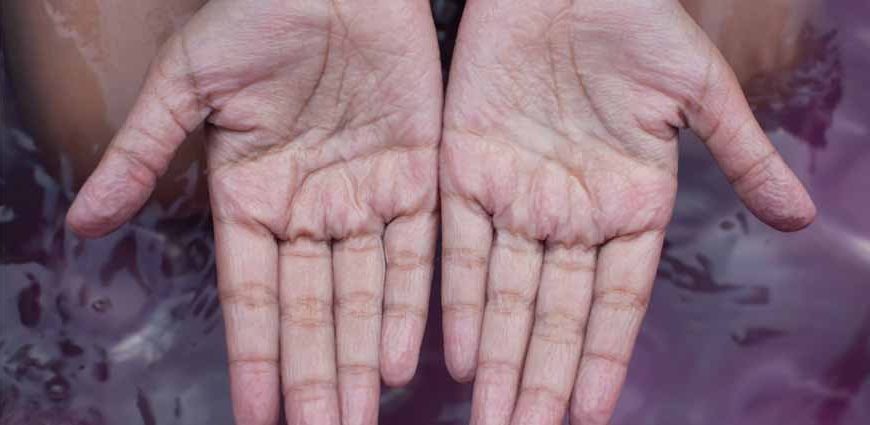When your child asks you why their fingers and toes wrinkle in the water, it might be difficult to know what reply to give. It’s a fascinating concept that has confused many people, but luckily, there is a way to explain it.
Be prepared with the responses the next time your child asks you the same question after a swim or bath! See what scientists think by reading on.
What is the science behind wrinkly fingers and toes?
When we stay in water for a while, our outer layer of skin called the epidermis starts to absorb water. However, the inner layers of your skin do not absorb water as quickly. This creates a situation where the outer layer swells with water, but the inner layers stay relatively unchanged.
Under our skin, we have a network of blood vessels that help regulate blood flow to different parts of our body. When we are in the water, our body recognises that our fingers and toes need better traction to grip wet surfaces. So, it sends signals to the blood vessels in those areas to constrict or get smaller.
When the blood vessels constrict, they reduce blood flow to our fingers and toes. As a result, the excess water in the outer layer of our skin is not supported by as much blood, causing it to wrinkle up.
Scientists believe that this wrinkling effect may have evolved as a way to improve grip on wet or submerged objects, similar to the treads that help them grip the route in wet conditions. So, while wrinkly fingers and toes might seem odd, they are actually a creative adaptation that helps us better interact with our watery environments!
Why does this happen only in our fingers and toes?
The wrinkling effect primarily occurs in our fingers and toes because these areas have a higher concentration of specialised nerves called “Pacinian corpuscles.” These nerves are particularly sensitive to changes in pressure and are responsible for detecting texture and aiding in our sense of touch.
When we submerge our hands and feet in water for an extended period, the nerve endings in our fingers and toes react to the increased moisture and pressure by sending signals to the brain. In response, the brain instructs the blood vessels in these areas to constrict, reducing blood flow to the skin’s surface.
Because of the unique characteristics of the skin of our fingers and toes, as well as the abundance of Pacinian corpuscles in these areas, they wrinkle more than other parts of the body. While wrinkles in other body parts may sometimes appear in water, they usually do not get as noticeable as they do in our fingers and toes.
What should I do if this happens to my child?
If you notice that your child’s fingers and toes are wrinkling after being submerged in water for a while, there’s generally no need to do anything special. The wrinkling is a natural response of the body and typically goes away on its own once he or she is out of the water for a bit.
However, if you find the wrinkling uncomfortable or if it persists for an unusually long time after leaving the water, you can simply dry off the hands with a towel. This can help speed up the process of returning the skin to its normal state.
Should we worry about this phenomenon?
No, there’s generally no need to worry about the wrinkling of fingers and toes in water. It’s a natural and temporary response of the body to being submerged in water for an extended period. In fact, it’s considered a normal and harmless reaction.
The wrinkling effect is believed to be an evolutionary adaptation that has improved grip and traction when handling objects in wet conditions. However, in modern times, it’s simply a fascinating quirk of our biology.
Once we are out of the water and our fingers and toes dry off, the wrinkles usually disappear on their own as the skin returns to its normal state. So, while it might look a little strange, it’s just our body’s way of adjusting to its environment and isn’t a cause for concern.
Benefits of wrinkling
While wrinkling of the fingers and toes in water might seem like a strange phenomenon, it serves some beneficial purposes:
- Improved Grip:
- Enhanced Sensitivity:
One of the main benefits of wrinkling is that it enhances our ability to grip wet or submerged objects. The wrinkles create small channels or ridges on the skin’s surface, which can help to channel water away and increase friction, providing better traction.
The wrinkling effect may also heighten our sense of touch in wet conditions. The increased surface area created by the wrinkles may amplify the sensitivity of the skin’s nerve endings, allowing us to better detect texture and changes in the environment.
Before you go!!
We want to introduce you to a leading educational institution – EuroKids.
At EuroKids, we understand that the early years are crucial for a child’s development, which is why we provide a stimulating and safe space where children can explore, learn, and grow at their own pace. Our curriculum is designed to nurture curiosity, creativity, and critical thinking skills, preparing children for future academic success and lifelong learning.
We take pride in our state-of-the-art facilities, equipped with age-appropriate resources and learning materials that stimulate creativity and imagination. Our experienced and passionate educators create a warm and supportive atmosphere where each child feels valued and encouraged to express themselves.
Enrol your child at EuroKids today and give them the gift of a strong foundation for success in school and in life. Join our diverse community of families who trust us to provide the highest quality education and care for their little ones. Together, let’s venture on an exciting journey of discovery and growth!














